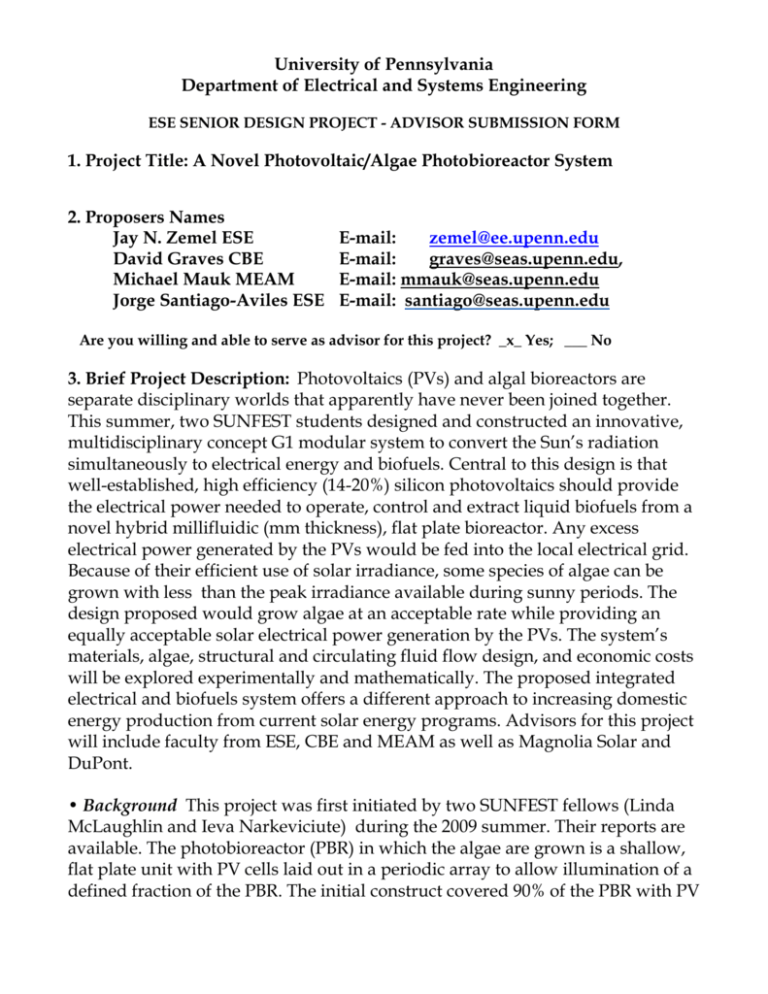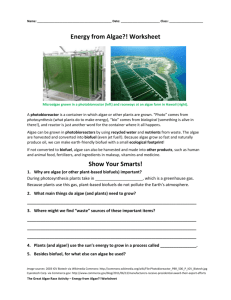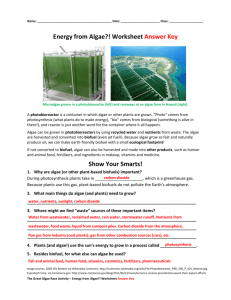A Novel Photovoltaic/Algae Photobioreactor System
advertisement

University of Pennsylvania Department of Electrical and Systems Engineering ESE SENIOR DESIGN PROJECT - ADVISOR SUBMISSION FORM 1. Project Title: A Novel Photovoltaic/Algae Photobioreactor System 2. Proposers Names Jay N. Zemel ESE David Graves CBE Michael Mauk MEAM Jorge Santiago-Aviles ESE E-mail: zemel@ee.upenn.edu E-mail: graves@seas.upenn.edu, E-mail: mmauk@seas.upenn.edu E-mail: santiago@seas.upenn.edu Are you willing and able to serve as advisor for this project? _x_ Yes; ___ No 3. Brief Project Description: Photovoltaics (PVs) and algal bioreactors are separate disciplinary worlds that apparently have never been joined together. This summer, two SUNFEST students designed and constructed an innovative, multidisciplinary concept G1 modular system to convert the Sun’s radiation simultaneously to electrical energy and biofuels. Central to this design is that well-established, high efficiency (14-20%) silicon photovoltaics should provide the electrical power needed to operate, control and extract liquid biofuels from a novel hybrid millifluidic (mm thickness), flat plate bioreactor. Any excess electrical power generated by the PVs would be fed into the local electrical grid. Because of their efficient use of solar irradiance, some species of algae can be grown with less than the peak irradiance available during sunny periods. The design proposed would grow algae at an acceptable rate while providing an equally acceptable solar electrical power generation by the PVs. The system’s materials, algae, structural and circulating fluid flow design, and economic costs will be explored experimentally and mathematically. The proposed integrated electrical and biofuels system offers a different approach to increasing domestic energy production from current solar energy programs. Advisors for this project will include faculty from ESE, CBE and MEAM as well as Magnolia Solar and DuPont. • Background This project was first initiated by two SUNFEST fellows (Linda McLaughlin and Ieva Narkeviciute) during the 2009 summer. Their reports are available. The photobioreactor (PBR) in which the algae are grown is a shallow, flat plate unit with PV cells laid out in a periodic array to allow illumination of a defined fraction of the PBR. The initial construct covered 90% of the PBR with PV cells leaving ~10% exposed to solar radiance. Time did not permit the SUNFEST Fellows to explore the potential of their system. 4. Project Design Objectives: •Project Goals By having a preliminary PBR-PV hybrid system immediately available, the first goal of the Senior Design project is to developa standard growth protocol for testing the effectiveness of spatially modulated L/D cycles. Controls for the circulating pumps will be needed. An uncovered PBR will be the reference initially. Sensors will be developed to monitor: 1. the growth rates in the covered and uncovered PBR; 2. power generated by different PV configurations. The goal is optimizing total energy conversion less the energy needed to extract biofuels from the algae For some parts of the study, standardized light sources (intensity), circulation velocity, L/D ratios, algae species, etc will be needed. Models need to be developed describing the circulation of algae in the PBR using mathematical modeling as a function of algae concentration, flow rate and temperature. A harvesting system based on the dynamics of the cell motion in the growth medium is needed. The goal is continuous concentration of the algae cells once an acceptably high concentration is achieved, i.e. one where the effective growth rate could provide reasonable yields. The goal for the 2009-2010 year is to obtain reproducible data on the feasibility of this proposed approach and, if possible, publish the information in the open literature. 5. Project Prerequisites: What specific knowledge (e.g. courses or topics) and skills (e.g. programming languages or software packages) will this project require? Please rank order the knowledge and skills you have identified, with the most important at the top of the list. This is a high risk, high potential project requiring a team with a variety of skills (including possibly Electrical and Systems Engineering, Biochemical and Chemical Engineering, Mechanical Engineering and Applied Mechanics, Materials Science and Engineering and BioEngineering). The fact that an individual student may not have had courses in specific aspects of the project is anything but a deterrent. What is needed is a willingness to learn and an interest in applying your knowledge to the energy issue. As currently defined, at least three student (one each from the various disciplines) would be needed. Because of the interdependent team nature of this project, students interested in this area should contact one or more of the faculty members for further information.









